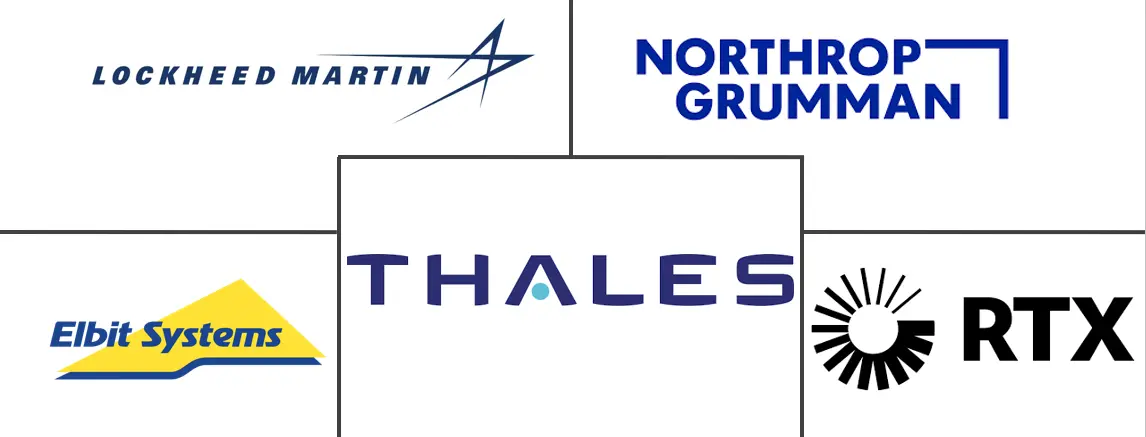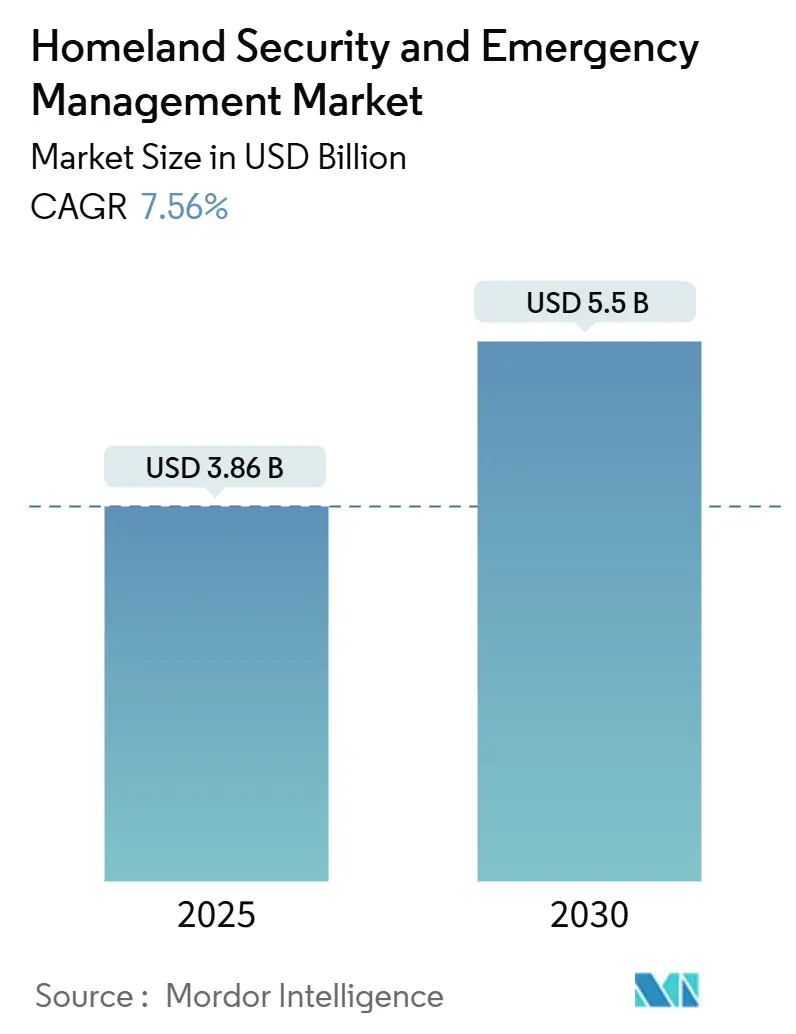
Homeland Security And Emergency Management Market Analysis by Mordor Intelligence
The homeland security and emergency management market was valued at USD 3.82 billion in 2025 and is on track to reach USD 5.5 billion by 2030, reflecting a 7.56% CAGR. Intensifying overlaps between cyber, physical, and environmental threats motivate governments and private operators to invest in integrated platforms that merge perimeter protection with real-time digital intelligence. State-sponsored cyberattacks, rising geopolitical frictions, and more frequent climate-driven disasters are expanding the addressable scope of the homeland security and emergency management market, while emerging technologies such as 5G, cloud, and AI deliver the scale required for nationwide rollouts. Competitive intensity is growing as defense primes partner with cloud and telecom players to field modular solutions for critical infrastructure, public safety communications, and border management. At the same time, purchasing decisions are moving toward outcome-based contracts in which vendors must demonstrate faster incident response and measurable risk reduction. As procurement frameworks mature, regional differentiation is widening: North America adopts zero-trust cyber architectures, Asia accelerates smart-city surveillance deployments, and Europe mandates strict data-protection safeguards alongside cross-border intelligence sharing.
Key Report Takeaways
- By solution type, critical infrastructure security held 21.52% of the homeland security and emergency management market share in 2024, while maritime and port security is advancing at an 8.46% CAGR through 2030.
- By technology, cloud security platforms accounted for 22.27% of the homeland security and emergency management market size in 2024; 5G and secure communications top the growth chart at 9.13% CAGR to 2030.
- By end-use vertical, the government and public sector led with 32.39% revenue share in 2024; healthcare and EMS are projected to expand at 9.49% CAGR between 2025 and 2030.
- By geography, North America commanded 36.81% of the homeland security and emergency management market share in 2024, whereas Asia is set to grow fastest at 9.21% CAGR through 2030.
Global Homeland Security And Emergency Management Market Trends and Insights
Drivers Impact Analysis
| Driver Impact Analysis | (~) % Impact on CAGR Forecast | Geographic Relevance | Impact Timeline |
|---|---|---|---|
| Escalating state-sponsored cyberattacks on critical infrastructure | +2.10% | Global, focus on North America and Europe | Short term (≤ 2 years) |
| Mandatory NG911 / EU-112 public warning system compliance deadlines | +1.40% | North America and EU | Medium term (2-4 years) |
| AI-enabled video analytics roll-outs in GCC and Asian megacities | +1.10% | APAC and Middle East | Medium term (2-4 years) |
| 5g private network adoption inside military bases | +1.80% | Global, early in North America | Medium term (2-4 years) |
| Maritime chokepoint disruptions boosting integrated maritime domain awareness spend | +0.80 | Global sea lanes | Short term (≤ 2 years) |
| Climate-driven severe weather events driving mobile emergency operation centers | +1.00 | Coastal regions worldwide | Long term (≥5 years) |
| Source: Mordor Intelligence | |||
Escalating State-Sponsored Cyberattacks on Critical Infrastructure
Nation-state groups have shifted from intelligence gathering to the placement of dormant malware within electric grids, ports, and water systems. The FBI disclosed that Volt Typhoon maintained covert access to US transport networks for over five years and could launch disruptive actions during conflict events.[1] Dan Sabbagh, “Chinese hackers ‘already targeting US infrastructure’, says FBI,” The Guardian, guardian.com Operators are therefore retiring perimeter-centric defenses in favor of zero-trust models that continuously validate every device and user. Energy utilities segment operational-technology networks, while airports apply behavioral analytics to spot suspicious lateral movement. These measures have pushed cybersecurity spending toward identity management, encrypted industrial protocols, and continuous network monitoring. As ransomware overlaps with geopolitically motivated sabotage, insurance premiums have risen, elevating the total cost of inaction and spurring additional safeguards.
Mandatory NG911 / EU-112 Public Warning System Compliance Deadlines
Regulatory calendars in the United States and European Union mandate next-generation emergency call routing, location precision under three meters, and multimedia exchange between dispatchers and first responders. Compliance projects require cloud-based call handling, redundant fiber backbones, and cybersecurity certification aligned with NIST and ETSI standards. Counties already upgraded report lower call abandonment rates and faster triage of multi-casualty events. Vendors supplying IP core services, geospatial analytics, and cyber-hardened radio gateways benefit directly, while system integrators capture extended maintenance contracts. Because public warning systems must interface with private telecom networks, cross-border standards are tightening, accelerating platform convergence across continents.
AI-Enabled Video Analytics Roll-outs in GCC and Asian Megacities
Smart-city programs in Dubai, Riyadh, and Singapore now treat proactive threat detection as vital to urban resilience. Municipal command centers ingest feeds from thousands of cameras, drones, and fixed sensors, applying computer vision to flag abandoned objects or crowd anomalies within seconds. The US Department of Homeland Security echoed this shift by deploying automated target recognition to detect prohibited items in travel lanes.[2] US Department of Homeland Security, “Roles and Responsibilities Framework for Artificial Intelligence in Critical Infrastructure,” dhs.govAI modules reduce false alarms, freeing officers for high-value tasks. Edge processing inside cameras limits bandwidth needs and protects privacy by transmitting only metadata. As accuracy climbs across demographics, municipalities negotiate usage boundaries with civil-society groups to balance safety and civil liberties.
5G Private Network Adoption Inside Military Bases
Dedicated 5G cells installed at training grounds and logistics hubs support secure, low-latency video from unmanned ground vehicles and rapid sensor data exchange within the Joint All-Domain Command and Control framework. The US 2024 National Defense Authorization Act allocated USD 179 million for open-RAN pilot sites, mandating that spectrum be reconfigurable to minimize jamming risk.[3] Jared Keller, “DoD Spending Plan Gives Boost to 5G Research,” Military Embedded Systems, militaryembedded.com Zero-trust principles govern each connection, while post-quantum cryptography pilots aim to future-proof mission data. Similar initiatives appear in Australia, Japan, and NATO training ranges, boosting demand for ruggedized small cells, secure SIM provisioning, and automated spectrum management.
Restraints Impact Analysis
| Restraints Impact Analysis | (~) % Impact on CAGR Forecast | Geographic Relevance | Impact Timeline |
|---|---|---|---|
| Fragmented multi-jurisdiction procurement slowing platform standardization | −1.5% | Global, stronger in federal systems | Medium term (2-4 years) |
| Litigation and moratoria on facial-recognition surveillance in EU and US cities | −0.8% | EU, US cities | Short term (≤ 2 years) |
| Cyber-talent shortages creating greater than 20% vacancies in government SOCs | −1.3 % | Developed economies | Medium term (2-4 years) |
| Emerging-economy budget reallocations away from capital-intensive CBRNE systems | −0.5 % | Emerging markets | Short term (≤ 2 years) |
| Source: Mordor Intelligence | |||
Fragmented Multi-Jurisdiction Procurement
Emergency agencies often buy radios, sensors, and analytics platforms under separate grant programs, creating incompatible data schemas obstructing mutual aid. The US Government Accountability Office estimates that eliminating duplicated homeland security contracts could save hundreds of millions. Parallel challenges surface in Europe, where municipal surveillance software can struggle to integrate with national border systems. Vendors must provide middleware that translates between proprietary formats, but the additional engineering cost slows rollout schedules and increases total project price, tempering near-term growth.
Litigation and Moratoria on Facial-Recognition Surveillance
Privacy advocates have secured temporary bans on real-time facial scans in San Francisco, Portland, and several EU capitals. Courts cite concerns over algorithmic bias and mass surveillance. In response, the DHS issued a facial-capture policy that lets US citizens opt out of certain non-law enforcement uses and mandates independent bias testing. While airports and border crossings continue to deploy the technology within narrow use cases, city police agencies delay investments until legal clarity improves. Suppliers are enhancing demographic parity and adding consent management layers, but revenue from broad public-space deployments remains capped in the short term.
Segment Analysis
By Solution Type: Critical Infrastructure Remains Anchor, Maritime Gains Momentum
Critical infrastructure security generated the largest revenue slice in 2024, underscoring heightened concern over the resilience of electricity, water, and transportation assets. The segment's 21.52% homeland security and emergency management market share arose after publicized attempts to compromise rail signaling and pipeline monitoring networks. Utilities responded by segmenting supervisory control and data acquisition (SCADA) traffic, deploying intrusion detection at substations, and integrating incident-response playbooks with federal fusion centers. This segment's homeland security and emergency management market size is forecast to rise steadily on continued grant allocations, mandatory cyber incident reporting rules, and the incorporation of digital twins that enable predictive maintenance.
Although smaller in absolute terms, maritime and port security are projected to expand at 8.46% CAGR through 2030, reflecting the strategic value of seaborne trade lanes, NATO's Baltic Sentry drone flotilla, and commercial AI systems that flag vessels deviating from declared routes highlight a broader commitment to maritime domain awareness. Ports pair surface radars with underwater acoustics to detect unauthorized divers near fiber cables. As insurance underwriters demand robust monitoring to cover sabotage risks, procurement of autonomous patrol boats and AI-scored risk dashboards accelerates. Additional growth drivers include decarbonization mandates that require new emission-tracking sensors, further widening the solution scope within the homeland security and emergency management market.
Other solution lines—CBRNE detection, perimeter protection, aviation security, and risk and emergency services—add redundancy across the threat spectrum. While their share fluctuates, integrated command-and-control platforms allow agencies to visualize alerts from all subsystems in a single pane, simplifying incident orchestration.
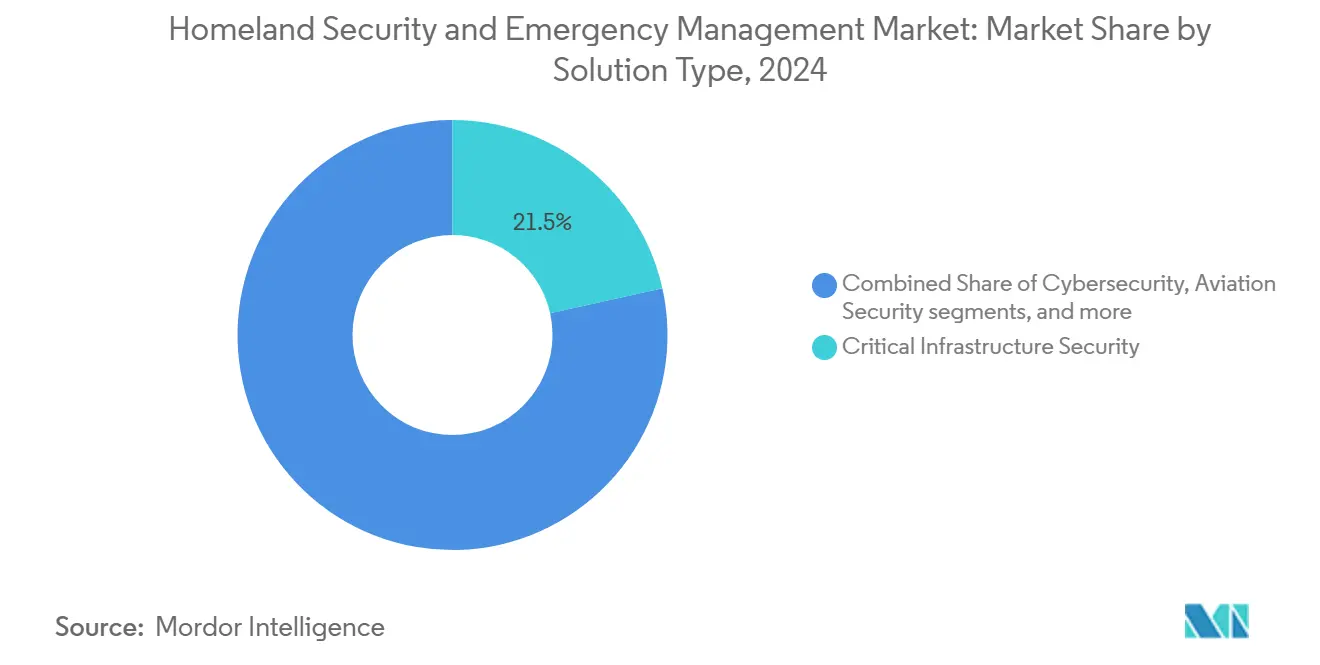
Note: Segment shares of all individual segments available upon report purchase
By Technology: Cloud Dominates Yet 5G Leads Growth Curve
Cloud security platforms represented 22.27% of the homeland security and emergency management market size in 2024 because agencies prioritized flexible compute environments to ingest growing sensor volumes. FedRAMP-authorized frameworks enable real-time correlation of cyber indicators, while continuous monitoring tools automate compliance reporting. Several state fusion centers reduced average patch cycles from weeks to days after migrating security analytics to the cloud, demonstrating measurable resilience improvements. Vendors differentiate through automated evidence gathering, machine-learning-based anomaly detection, and hardened enclaves for classified workloads. As multicloud adoption rises, secure API gateways and policy-as-code solutions underpin interoperability.
Conversely, 5G and secure communications exhibit the fastest CAGR of 9.13% through 2030. Base commanders cite the need for deterministic latency below 10 milliseconds to support coordinated drone swarms and augmented-reality maintenance. Private network rollouts pair millimeter-wave radios with network-slicing software that isolates mission traffic from commercial users. Edge encryption chips ensure data privacy even if a node is compromised. This upward trajectory positions 5G as a cornerstone for expanding the homeland security and emergency management market size across incident management, telemedicine, and autonomous logistics.
Complementary technologies such as AI, smart sensors, big data analytics, and biometrics reinforce each other. AI engines streamline triage of millions of monthly alerts, while smart sensors reduce blind spots across isolated terrain. As these capabilities mature, integration layers become the competitive battleground rather than individual sensor performance.
By End-Use Vertical: Government Sustains Leadership, Healthcare Accelerates
Government and public sector agencies accounted for 32.39% of 2024 spending. Statutory responsibility for national defense and disaster response guarantees recurring budgets even during economic contractions. Federal cybersecurity executive orders require agencies to adopt zero-trust frameworks, spurring multiyear modernization pipelines. Emergency management operations centers upgrade voice-over-IP dispatch consoles and deploy AI-assisted situation maps that visualize resource allocation in real time. These investments cement the government’s primacy within the homeland security and emergency management market.
Healthcare and emergency medical services are the fastest-rising vertical, projected at 9.49% CAGR. Hospital networks classified as critical infrastructure face ransomware threats that jeopardize patient safety. In response, administrators install network segmentation, biometric access controls for drug dispensaries, and disaster-recovery data vaults. EMS teams equip ambulances with 5G tablets that stream ultrasound images to emergency physicians, cutting triage times. The homeland security and emergency management market size for healthcare further benefits from tele-health expansion and mandates to secure patient data under revised HIPAA security rules.
Industrial facilities, defense installations, and the transportation sector round out demand. Each has distinct risk profiles yet converges on the same underlying need for unified threat visibility and rapid recovery mechanisms.
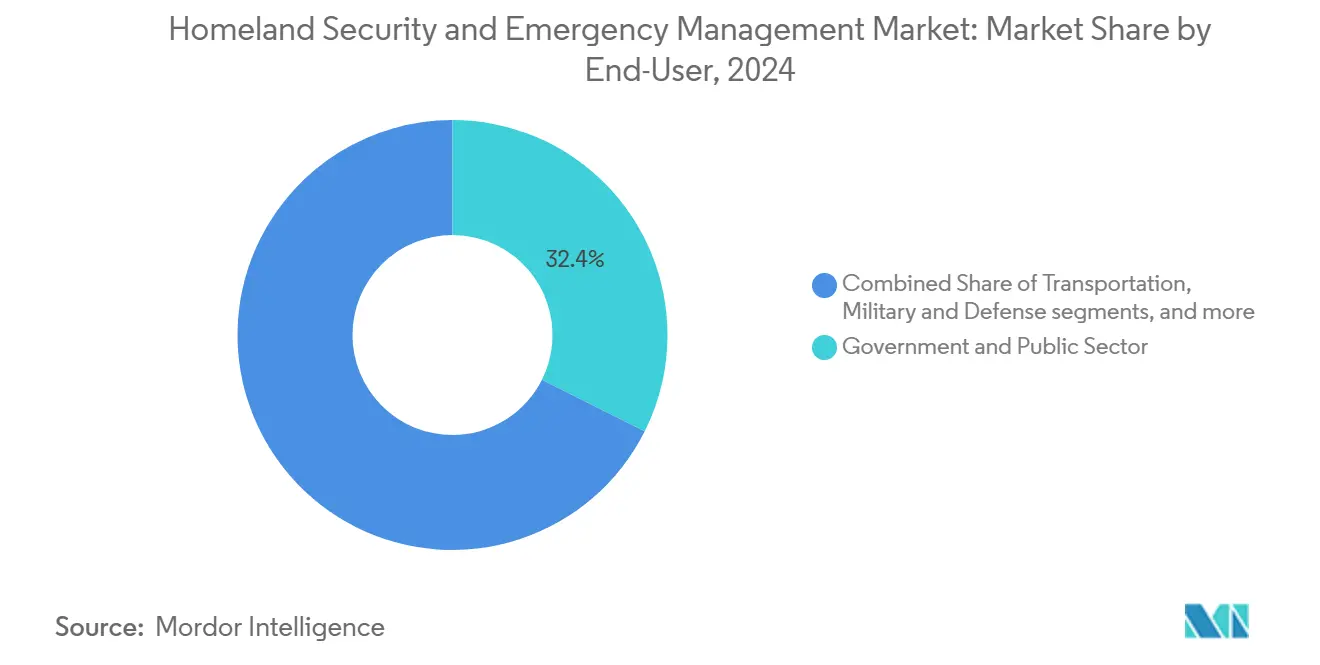
Note: Segment shares of all individual segments available upon report purchase
Geography Analysis
North America led with a 36.81% share in 2024, supported by robust federal appropriations for critical-infrastructure defense and extensive collaboration between agencies and private operators. The Port of Los Angeles blocked 750 million hacking attempts in 2024, illustrating the attack volume shaping purchasing priorities.[4]Jonathan Vanian, “Biden Administration Steps Up Cybersecurity for US Ports,” CNBC, cnbc.com Zero-trust adoption rates outpace other regions, and grant frameworks such as the Infrastructure Investment and Jobs Act funnel funds toward resilience upgrades.
Asia-Pacific is the growth engine, expanding at 9.21% CAGR. Rapid urbanization and megacity investments create fertile ground for AI-enabled surveillance, smart evacuation corridors, and resilient telecom backbones. The 2024 Noto Peninsula earthquake exposed gaps in sensor coverage and spurred fast-track procurement of integrated warning platforms. Meanwhile, rising semiconductor fabs across Taiwan and South Korea require strict security perimeters and air-gap cyber defenses, intensifying regional spend.
Europe maintains a sizeable position through stringent regulatory mandates and joint border-management initiatives. Projects such as the biometric upgrade at Beirut-Rafic Hariri International Airport demonstrate the export of European standards beyond the continent. Funding from the EU Internal Security Fund underpins cross-border data-sharing hubs.
The Middle East continues to direct oil revenues toward layered airport, energy-facility, and public-venue protection systems. Africa and Latin America advance more slowly but prioritize maritime and disaster-response capabilities in coastal cities prone to hurricanes and cyclones.
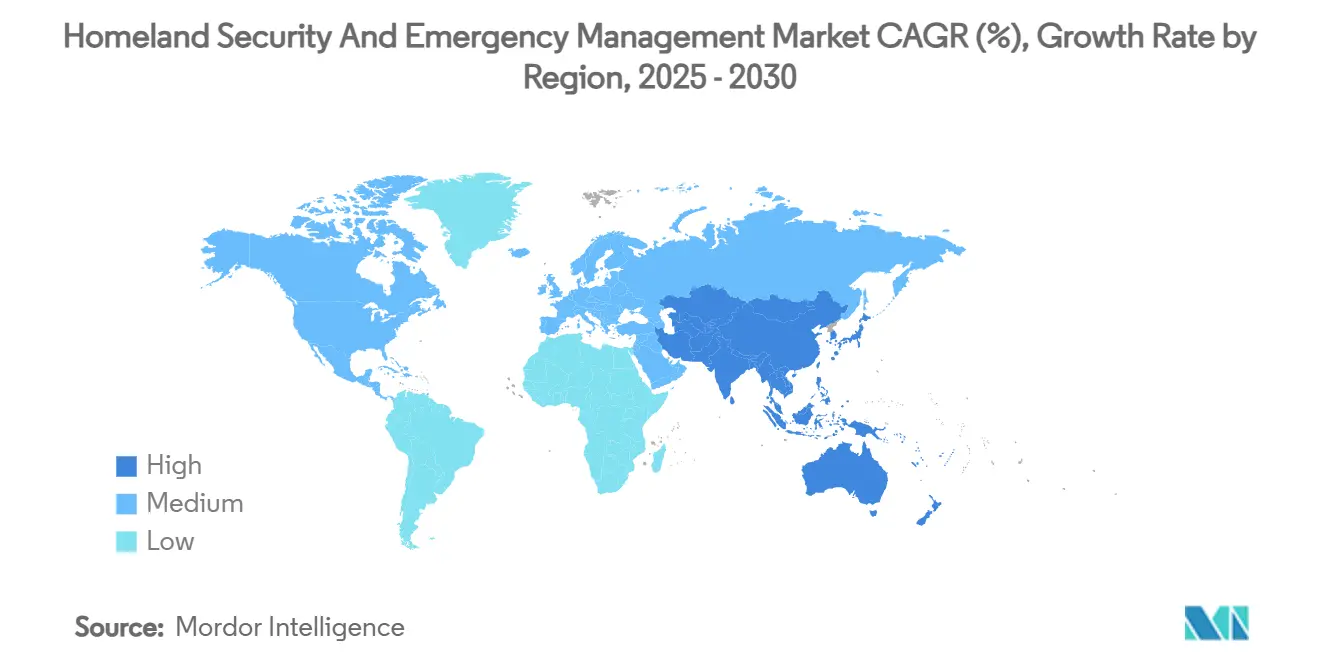
Competitive Landscape
Industry structure is moderately concentrated, with firms like Thales Group, Lockheed Martin Corporation, RTX Corporation, and Northrop Grumman Corporation leveraging decades of program performance and in-house R&D to capture long-cycle contracts. Thales secured EUR 10.8 billion of new orders in the first half of 2024, raising its record backlog to EUR 47 billion and underscoring sustained demand for integrated solutions.[5]Thales Group, “Half-Year 2024 Results,” thalesgroup.com
Strategic partnerships dominate. Cloud hyper-scalers team with radar and missile-defense providers to offer analytics-as-a-service, while telecom carriers bundle 5G private-network services with threat-detection subscriptions. Lockheed Martin’s USD 4.1 billion C2BMC-Next award illustrates how the convergence of space, cyber, and missile-defense drives platform unification.
Niche disruptors add competitive tension. Windward uses maritime behavioral data to deliver early-detection algorithms that flag stealth vessels within minutes. Start-ups focusing on quantum-safe encryption, secure-mesh drones, or deception technology attract venture funding and could displace incumbent modules in multi-vendor stacks.
Pricing pressure remains modest because mission-critical credentials, export controls, and sovereign data requirements limit direct substitution. However, as artificial intelligence models commoditize, value shifts to proprietary threat-intelligence feeds and integration expertise.
Homeland Security And Emergency Management Industry Leaders
-
Lockheed Martin Corporation
-
Northrop Grumman Corporation
-
Thales Group
-
RTX Corporation
-
Elbit Systems Ltd.
- *Disclaimer: Major Players sorted in no particular order
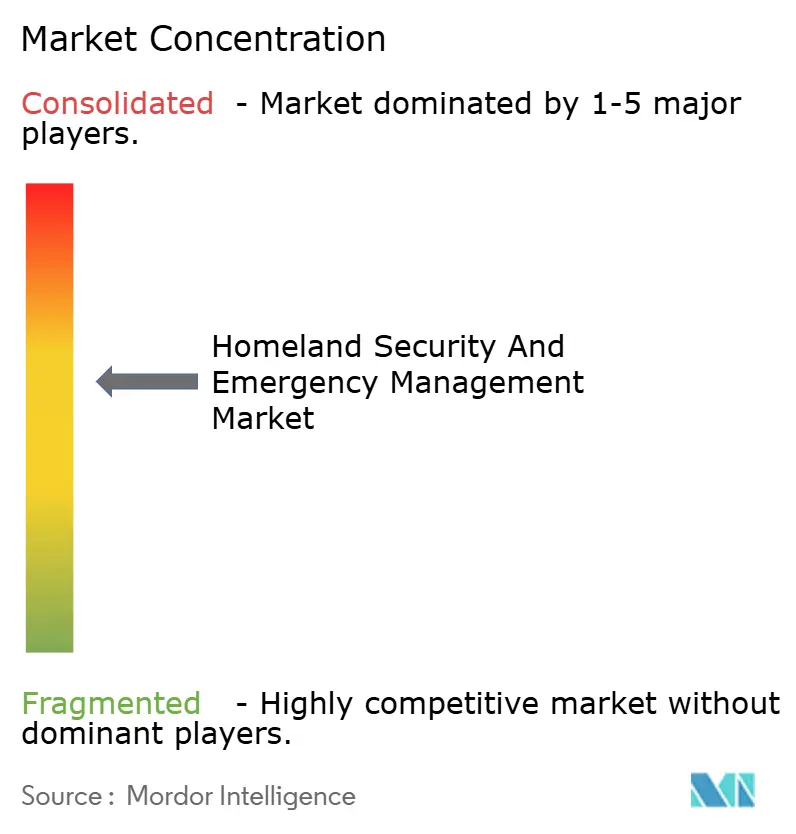


Recent Industry Developments
- February 2025: The US Department of Homeland Security issued the “Generative AI Public Sector Playbook” to standardize responsible adoption across agencies.
- February 2025: NATO deployed the Baltic Sentry autonomous naval drone fleet to guard subsea pipelines and cables.
- November 2024: ASRC Federal captured a USD 17 million zero-trust integration contract for US Citizenship and Immigration Services.
- June 2024: Thales and France’s CEA embarked on a three-year R&D program to build trusted generative-AI systems for defense intelligence.
Research Methodology Framework and Report Scope
Market Definitions and Key Coverage
Our study treats the Homeland Security & Emergency Management market as all spending directed toward integrated prevention, response, and recovery programs that protect civilian populations, critical infrastructure, and digital assets from terrorism, cyber-intrusions, natural hazards, and large-scale accidents. Values capture hardware, software, and managed services purchased by public authorities and their mandated private partners.
Scope exclusion: routine defense procurement (e.g., combat platforms) and private-only enterprise security projects are left outside this valuation.
Segmentation Overview
- By Solution Type
- Critical Infrastructure Security
- CBRNE Detection and Protection
- Perimeter and Physical Security
- Cybersecurity
- Border Security and Immigration Control
- Maritime and Port Security
- Aviation Security
- Risk and Emergency Services
- By Technology
- AI and Machine Learning
- IoT and Smart Sensors
- Big-Data Analytics
- 5G and Secure Communications
- Cloud Security Platforms
- Biometric Identification
- By End-Use Vertical
- Government and Public Sector
- Critical Infrastructure (Energy, Utilities)
- Military and Defense
- Transportation (Aviation, Maritime, Rail)
- Commercial and Industrial Facilities
- Healthcare and Emergency Medical Services
- By Geography
- North America
- United States
- Canada
- Mexico
- Europe
- United Kingdom
- France
- Germany
- Italy
- Rest of Europe
- Asia-Pacific
- China
- India
- Japan
- South Korea
- Rest of Asia-Pacific
- South America
- Brazil
- Argentina
- Rest of South America
- Middle East and Africa
- Middle East
- Saudi Arabia
- United Arab Emirates
- Israel
- Rest of Middle East
- Africa
- South Africa
- Egypt
- Rest of Africa
- Middle East
- North America
Detailed Research Methodology and Data Validation
Primary Research
We interview procurement officers, emergency-service chiefs, cybersecurity advisors, and technology vendors across North America, Europe, the Gulf, and key Asia-Pacific economies. Conversations test data gaps around unit pricing, deployment pace, and grant disbursement schedules, ensuring local nuances feed the model before sign-off.
Desk Research
Analysts first map the universe of government outlays and enabling regulations using open datasets such as the US Congressional Budget Justification Books, Eurostat COFOG tables, UNDRR disaster loss statistics, WTO customs filings, and position papers from bodies such as INTERPOL and the World Customs Organization. Company 10-Ks, GAO audit reports, and reputable press help us benchmark contract pipelines and average selling prices. Select paid intelligence, D&B Hoovers for contractor financials, and Dow Jones Factiva for deal tracking add depth. The sources listed above illustrate, yet do not exhaust, the wider corpus consulted for cross-checks and clarification.
Market-Sizing & Forecasting
A top-down reconstruction of national security and civil-protection budgets, aligned to OECD COFOG codes, anchors 2025 spending. Results are then corroborated with a bottom-up sample of supplier roll-ups and channel checks. Variable selection centers on five fingerprints: 1) annual homeland-security appropriations, 2) frequency of FEMA-level disaster declarations, 3) critical-infrastructure cyber incident counts, 4) NG911 or EU-112 upgrade progress, and 5) average AI-enabled surveillance adoption rates. Multivariate regression projects each driver to 2030 under baseline, upside, and stressed scenarios; scenario probabilities are tuned with expert consensus. Where supplier revenue splits are opaque, we gap-fill using three-year moving averages of comparable contracts.
Data Validation & Update Cycle
Model outputs undergo variance scans against independent indicators, after which senior reviewers challenge anomalies. Reports refresh every twelve months, and we trigger interim updates when supplemental budgets, major attacks, or disaster events alter fundamentals. A final analyst pass immediately precedes client delivery.
Why Mordor's Homeland Security And Emergency Management Baseline Earns Trust
Published estimates often diverge because studies frame "homeland security" through different lenses, apply varied price stacks, or freeze exchange rates at dissimilar points.
Key gap drivers include: some studies fold all military modernizations into the tally, others inflate totals by layering private enterprise security, and refresh rates differ, causing currency swings or post-event surges to be missed.
Benchmark comparison
| Market Size | Anonymized source | Primary gap driver |
|---|---|---|
| USD 3.82 B (2025) | Mordor Intelligence | - |
| USD 806.47 B (2025) | Regional Consultancy A | Combines defense capital programs and private cybersecurity, widening scope dramatically |
| USD 617.72 B (2025) | Global Consultancy B | Treats all resilience-oriented ICT for smart cities as part of the market, raising totals |
| USD 676.67 B (2025) | Trade Journal C | Uses supplier revenue headlines without adjusting for multi-year backlog recognition |
Taken together, the comparison shows that Mordor's disciplined scope, budget-linked variables, and annual refresh cadence yield a balanced, transparent baseline that decision-makers can replicate and stress-test with confidence.


Key Questions Answered in the Report
What is the current Homeland Security and Emergency Management Market size?
The homeland security and emergency management market was valued at USD 3.82 billion in 2025 and is on track to reach USD 5.5 billion by 2030, reflecting a 7.56% CAGR.
Which region leads spending?
North America holds the largest share at 36.81%, driven by federal cybersecurity and critical-infrastructure programs.
Which segment is expanding fastest?
Maritime and port security shows the highest growth rate, projected at 8.46% CAGR between 2025-2030 due to heightened maritime-infrastructure threats.
Why are cloud platforms important to homeland security?
Cloud security platforms enable real-time sharing of threat intelligence, automated compliance, and scalable analytics, making them the largest technology segment at 22.27% share.
How will 5G influence emergency management?
Private 5G networks provide low-latency, high-reliability links for drones, sensors, and field medics, underpinning the fastest-growing technology segment at 9.13% CAGR.
Page last updated on:
